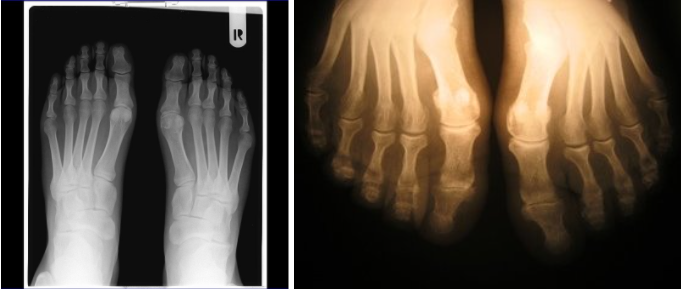‘Step forward’ - Exercise and Foot Osteoarthritis
A great way to start yet another article about osteoarthritis (OA) is to revisit its definition!
OA describes inflammation of a joint and its nearby structures such as the bones, ligaments, capsule and cartilage. OA can show itself in various joints, commonly the knee, hip, shoulder and hands. If it affects any of the foot joints, it is thereafter named as foot OA.
 The foot have an incredible number of bones and joints that allow for complex movements and function
The foot have an incredible number of bones and joints that allow for complex movements and function
Foot joints are involved in weight-bearing tasks, such as walking, jogging, getting up onto your toes to reach for the top cabinet and kneeling and getting up and down from the floor. This means that painful foot joints can be a significant barrier to day-to-day activities and exercise.
Here at Be Mobile Physiotherapy, our mission is to help reduce the barriers to exercise, so that you can achieve long term fitness goals! In this article, we will take a look at what scientific research says about foot OA, and what you can do to start or continue on your exercise journey.
What does evidence say about foot OA?
Compared to other forms of OA (e.g., knee OA, hip OA), research and evidence based around foot OA is minimal. There is a lack of high quality, unbiased studies (i.e., randomized controlled trials) to appropriately address effective interventions for people experiencing foot OA and its related symptoms (2).
Common modes of intervention and management considered are: custom orthoses, footwear, surgery and exercise.
Custom Orthoses and footwear are commonly recommended to address foot OA related symptoms. In theory, this method of intervention aims to reduce symptoms during weight bearing and movement tasks by altering the way your body weight is distributed. However, there are a couple of issues with this:
- The evidence regarding their effectiveness is unclear (1)
- There is a lack of both quality and quantity of research specific to foot OA.
With such limited available information, it is unclear whether custom orthoses and footwear are truly effective for everyone, but they can be considered as a potential, or secondary form of management of foot OA.
Surgery is an extreme measure of intervention for foot OA. Although it may be recommended for those with significant disease progress, it is important to consider that surgery is not without significant risk:
- Surgery is not a guaranteed solution
- Many continue to experience symptoms after surgery
- Adverse health risks involved with surgery (e.g., infection, general anesthesia)
We recommend that non-surgical interventions (e.g., custom orthoses, footwear, exercise) be trialled prior to considering surgical methods to avoid unnecessary risks.
Exercise is extremely important regardless of the severity of foot OA symptoms. This is largely due to the fact that our ability to move is dependent on our muscles, and our muscles lose their capacity to function if we don't use them. Furthermore, exercise comes with heaps of other health benefits!
- Check out our video about why exercise is so beneficial!
Now, you may be asking.. “how can I manage my symptoms so that I can continue to exercise?” Here’s what we recommend:
- ‘Start low and go slow’ - Find what movements and exercises are tolerable, and consider that as your starting point. From there, gradually increase the intensity (e.g., walking distance, squats with heavier weight) within tolerable limits, and so on.
- Use symptoms as a guide - tolerable symptoms and you can persist, but beyond that you can take a step back and reassess another time! Remember that there are other exercises you can do instead - upper body movements for example.
- Include specific foot exercises in your regular routine - this can involve any stretches, or movements that may provide you with some relief, such as getting up onto your toes, or using your hands to stretch your toes. You can do this before or after your workouts, or during the day if that suits you better. There is no right or wrong here - if it works for you, that’s the way!
If you want more ideas, check out Brodie’s demonstration of fun foot exercises.
Also, keep in mind the physical activity guidelines that you should be meeting each week:
- 150 minutes of moderate, or 75 minutes of vigorous exercise
- At least 2 strength training sessions per week
If you are ready to get started with some more structured strength training and exercise, we have free workouts for you to do on our Be Mobile Exercise Platform. You can create a totally free account by heading to our website!
In summary..
There is a lack of high quality research and consensus for the management of foot osteoarthritis.
Commonly recommended interventions, such as custom orthoses and footwear may vary in effectiveness, and can be considered as secondary form of management.
Specific foot exercises can be incorporated into your regular routine to help maintain your functional capacity and manage symptoms.
Exercise provides so many health benefits; foot OA symptoms should be managed as to not hinder ongoing exercise bouts.
References
- Hawke, F. E., Burns, J., Radford, J. A., & du Toit, V. (2007). Custom-made foot orthoses for the treatment of Foot Pain. Cochrane Database of Systematic Reviews. https://doi.org/10.1002/14651858.cd006801
- Roddy, E., & Menz, H. B. (2018). Foot osteoarthritis: Latest evidence and developments. Therapeutic Advances in Musculoskeletal Disease, 10(4), 91–103. https://doi.org/10.1177/1759720x17753337


